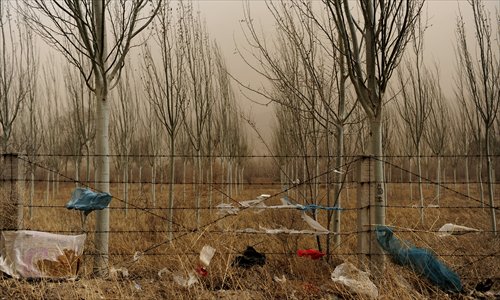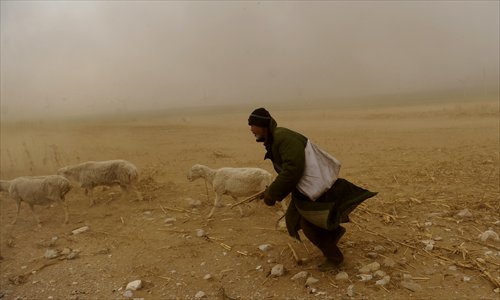Death of Beijing's dust shield

Plastic bags are seen on mesh wires protecting a forest in Huailai county, Hebei Province, on April 12, 2010. Photo: CFP

A local man follows his sheep during a dust storm on April 12, 2010. Photo: CFP
Beijing residents are well acquainted with the dusty weather that hits the city almost every spring, prompting many to wear breathing masks amid the red and brown gloom.
The dust makes its way down from the deserts of Inner Mongolia, and can often block the sun for hours. This nightmare hit Beijing yet again in March this year and the Central Meteorological Observatory labeled it the worst dust storm since the 1990s. An impressive feat, given the fact that on one day in April 2006, 30 tons of sand rained down upon the city within 24 hours.
However, older residents can remember a time when things were much worse. "Dust storms are less serious and frequent than they used to be, thanks to the Green Great Wall project," Wei Jianguo, a local resident in his 50s, told the Global Times.
Launched in 1978, the Great Green Wall project comprised a massive strip of trees through Zhangbei county in Hebei Province, which absorbed the brunt of the sandstorms heading toward Beijing. Now however, visitors to the area say the trees are dying, and as they wither, so too may the shield that has protected Beijing.
Falling down
An anonymous student with the Shanghai Maritime University, who is involved in a student union project to assess the condition of the greenbelt, told the Global Times that she was appalled to see trees dying en masse in Zhangbei county.
"The trees seem fine if you look from distance, but once you take a closer look at the trunk, you can see it has already dried up. I don't know the exact number, but both our interviews and investigations say it may be more than half of the whole forest in the county," the student added.
These losses haven't been sudden. Yuan Miaozhi, a local advocate for greenbelt protection, pointed out that locals have been witnessing the forest shrink for years, and said that the trees began to wither as early as 2003.
Dry conditions caused the situation to worsen in 2009 as the drought killed off many trees. The situation was exacerbated by the fact that most of the greenbelt was made up of poplar trees, which were chosen because they were cheap and grew rapidly. Their drawback however, is their high water consumption.
"Some trees lost all their leaves within 30 days in 2009 and some parts of the forest are now gone as the dead trees were removed," Yuan noted, adding that many of the poplars are getting old.
The greenbelt project in Zhangbei covers an area of 503,480 hectares with over 86,000 hectares of man-made poplar forest. The numerous trunks slow down the wind speed and therefore reduce the amount of sand passing through.
Sun Baoping, a professor with Beijing Forestry University, told the Global Times that the greenbelt is located some 1,000 meters higher than Beijing at the border region between the Mongolian Plateau and the North China Plain, which also boosts its qualities as a windbreak. "It serves as a crucial ecological shelter for Beijing as it protects the city from being buffeted by sandstorms every year."
Millions of trees
The Green Great Wall project aimed to improve the environment in northern China and ameliorate the effects of sandstorms that used to bury infrastructure and farmland. It also aimed to reduce erosion from the Loess Plateau, where 500 million tons of water and soil resources used to wash away every year.
The Green Great Wall has now expanded to 26.47 million hectares across northern China, of which, the actual tree coverage has increased from 5.05 percent in 1977 to 12.04 percent.
"If the forest in Zhangbei is not properly preserved, Beijing will again be put under the direct impact of sandstorms from sandy areas like Otindag of Inner Mongolia," said Hu Jun, a research fellow with the desertification prevention and treatment office of the Beijing Municipal Bureau of Landscape and Forestry.
Hu pointed out that the rate of tree-planting in Beijing had increased rapidly. According to Xinhua, the Beijing municipal government plans to cover more than 60 percent of the areas not occupied by buildings or farmland with trees by 2017, and that the current figure is 55.5 percent, with a target of 57.4 percent by the end of 2013.
"However, the trees inside the city will not be able to resist the powerful gusts if the shield in Zhangbei is removed and the city is laid bare in the face of the dust and gusts. The sandstorms will make pollution control more difficult, as the density of PM10 (particulate matter of 10 microns or less in diameter) will be increased," Hu said, adding that the incidence of respiratory diseases will also increase.
To make matters worse, it's not only the greenbelt in Zhangbei that faces danger. A green shelter in Gansu Province is also at risk, as the poplars are suffering from attacks by insects, according to an anonymous research fellow with the Gansu Desert Control Research Institute, who told the Global Times that the poplars have become a breeding ground for long-horn beetles.
"The wind and the sandstorms will badly affect local agriculture if the forest keeps dying out. The local weather patterns will be affected as the trees have an influence on air humidity," the research fellow said.
Saving green areas
Experts reached by the Global Times unanimously agreed that new species should be introduced into the Green Great Wall to save the forests. Forestry Authorities in Zhangbei have taken some actions by establishing test plantations of Mongolian Scots Pine trees.
The new species is believed to be an ideal choice, as the long-life tree is tolerant of drought and grows relatively faster compared with other trees suitable for the area, according to Yuan.
Sun added that elm trees could be introduced into poplar forests as the sand-proof plant can reduce the damage caused by pests. He also suggested pruning the trees to encourage further growth.
"Poplars are quick to sprout, so we can replace the dying generation with new ones. But it should be noted that the forest must be renewed gradually, so as to guarantee the wind-proofing effect and prolong the life expectancy of the greenbelt project," Sun said.
However, Yuan told the Global Times that funding is still an issue. "Every hectare of forest costs about 54,000 yuan ($8,821), which is quite a lot of money for a poverty-stricken county like Zhangbei."